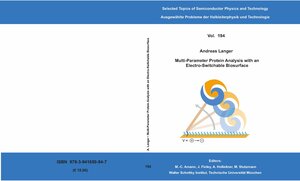
×
![Buchcover ISBN 9783941650947]()
Multi-Parameter Protein Analysis with an Electro-Switchable Biosurface
von Andreas LangerMeasurements in stationary or mobile phases are fundamental principles in protein analysis. Although the immobilization of molecules on solid supports allows for the parallel analysis of interactions, properties like size or shape are usually inferred from the molecular mobility under the influence of external forces. However, as these principles are mutually exclusive, a comprehensive characterization of proteins usually involves a multi‐step workflow. In this dissertation, I show how these measurement modalities can be reconciled by tethering proteins to a surface via dynamically actuated nanolevers. Short DNA strands, which are switched by alternating electric fields, are employed as capture probes to bind target proteins. By swaying the proteins over nanometer amplitudes and comparing their motional dynamics to a theoretical model, the protein diameter can be quantified with Angstrom accuracy. Alterations in the tertiary protein structure (folding) and conformational changes are readily detected. The general applicability of electrically switchable DNA layers for the efficient high‐ throughput screening of a large number of low molecular weight compounds is demonstrated at the example of the model enzyme human dihydrofolate reductase. An affinity ranking of several small molecules over a broad dynamic range is performed via a competitive assay and supplementary to the use as a bare screening tool, conformational changes between the binary and the ternary enzyme complex are uncovered.
Finally, the presented chip‐based method is used to study DNA polymerases and their interaction with nucleic acids. The association and dissociation of DNA polymerases is monitored in real‐time by analyzing changes in the DNA motion that occur due to polymerase binding. Chemical rate constants of association and dissociation, affinity constants and thermodynamic parameters are determined. The enzymatic activity is evaluated and even exonuclease activity can be observed. Simultaneously, information on the size of the DNA‐ polymerase complex is obtained and conformational changes in the ternary polymerase‐dNTP‐ DNA complex are revealed (match/mismatch situation).
Finally, the presented chip‐based method is used to study DNA polymerases and their interaction with nucleic acids. The association and dissociation of DNA polymerases is monitored in real‐time by analyzing changes in the DNA motion that occur due to polymerase binding. Chemical rate constants of association and dissociation, affinity constants and thermodynamic parameters are determined. The enzymatic activity is evaluated and even exonuclease activity can be observed. Simultaneously, information on the size of the DNA‐ polymerase complex is obtained and conformational changes in the ternary polymerase‐dNTP‐ DNA complex are revealed (match/mismatch situation).


